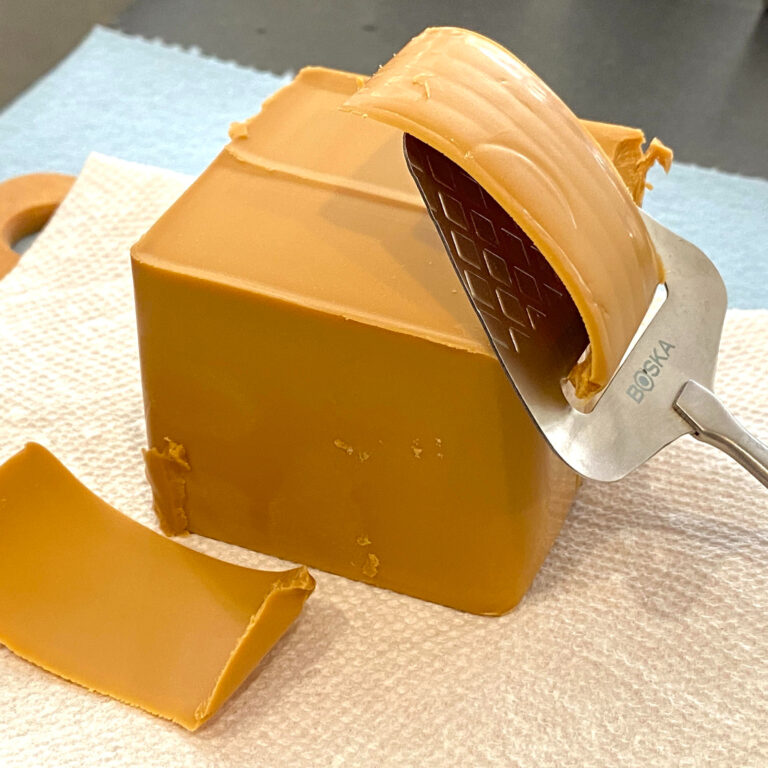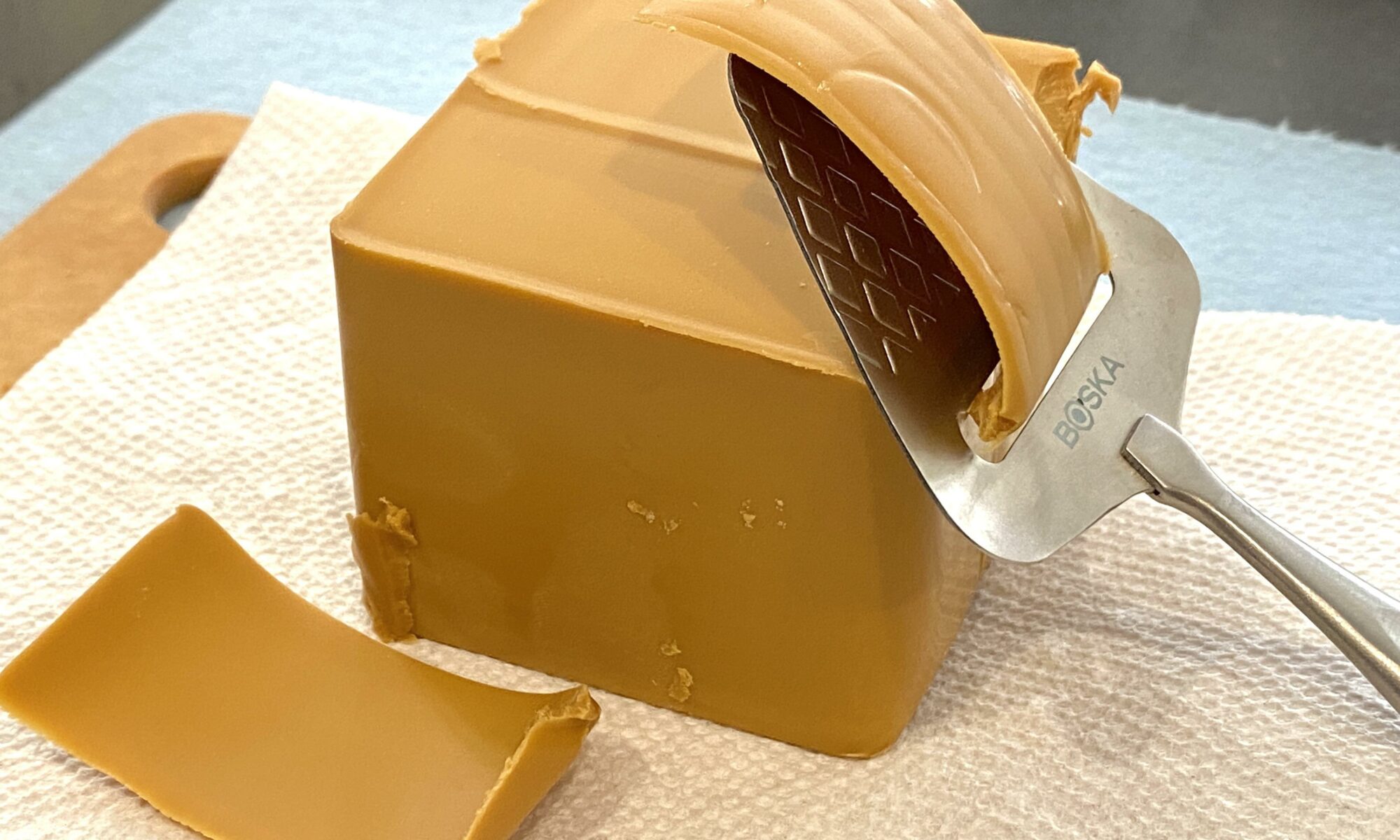23 september 2021 | 12 minutes

Norsk for Beginners is a podcast aimed at beginners of Norwegian (A1-A2). The episodes are structured in two parts: One Norwegian speaking part and the second in English, explaining the Norwegian part and examining some Norwegian vocabulary used in the episode. I speak Norwegian in a clear, slow and deliberate manner, perfect for beginners. Get some listening practice by listening to “Norsk for Beginners”!
Email: Laernorsknaa@gmail.com
Transcript: https://laernorsknaa.com/5-2-brown-cheese
Support me here –>
Patreon: https://www.patreon.com/laernorsknaa
Donasjon (Paypal): Doner (paypal.com)
For more content to learn Norwegian –>
YouTube: https://www.youtube.com/channel/UCxdRJ5lW2QlUNRfff-ZoE-A
Brunost
Brunost er en veldig norsk matvare. Kanskje du har prøvd det i Norge? Den er brun og søt. Konsistensen er ganske tykk. Brunost er ikke som annen ost. Det er kanskje best å ikke tenke på det som ost; det ligner kanskje mer på karamell. Brunost passer veldig godt sammen med syltetøy. Man kan bruke det i dessert eller bare på skiva. Men hva er egentlig brunost?
Vel, brunost er laget av myse. Myse er avfallet av osteproduksjonen. Myse er det som er igjen i melka etter at man har tatt ut ostestoffet. I vanlig ost bruker man ostestoffet i melka; det gjør man ikke i brunosten. Så brunost er veldig annerledes enn vanlig ost. De er laga av to helt forskjellige ting.
I Norge bruker vi ofte brunost som pålegg. Pålegg er det man har oppå skiva. Man kan altså ha det på brød. Jeg hadde selv ei brødskive med brunost med syltetøy på skolen hver eneste dag. Det er også vanlig å bruke brunost i desserter. For eksempel er det vanlig å ha brunost på vaffelen i Norge. Da tar man gjerne litt smør på vaffelen og noen skiver med brunost.
Det finnes ulike typer brunost. Faktisk finnes det en flytende brunosttype som heter prim. Prim har over 30% vann. Det gjør at det er mulig å smøre prim på skiva, akkurat som peanøttsmør. Ekte brunost har derimot mye mindre vann. Det gjør at de er faste. I Norge bruker vi ostehøvel til å skjære brunosten i skiver. I tillegg til vannmengden er det forskjell på hvor mye fløtebrunosten har i seg. Fløte er veldig fettholdig melk. Fettinnholdet kan variere fra 7% til 28% i brunosten. Det kan altså være veldig mye fett i brunost.
Brunost har veldig lange tradisjoner. De første kildene som nevner brunost er fra 1400-tallet i Norge. Denne brunosten hadde mye mindre fett i seg enn dagens moderne brunost. Denne brunosten blei laga på bondegårder rundt omkring i Norge. Den moderne brunosten blei funnet opp på 1800-tallet. Anne Haav laga oppskrifta på den første moderne brunosten på 1800-tallet. Hun bodde på en gård i Gudbrandsdalen på Østlandet. I 1908 begynte et meieri å masseprodusere brunosten til Anne Haav. Slik begynte den moderne brunosten å spre seg i hele Norge.

Episode’s Transcript
Heihei! Just a heads up before we start. I have a cold, so my voice is a bit different, but I will try to record this episode anyways. In this episode, we will look at one of the most Norwegian food items there are: The brown cheese. Before we start: You can support the podcast on Patreon.ref]https://www.patreon.com/laernorsknaa[/ref]. There is a link in the description. The transcript for the episode is available at the website, a link to which can be found in the description. Now, let’s talk about brown cheese.
Brunost
Brunost er en veldig norsk matvare. Kanskje du har prøvd det i Norge? Den er brun og søt. Konsistensen er ganske tykk. Brunost er ikke som annen ost. Det er kanskje best å ikke tenke på det som ost; det ligner kanskje mer på karamell. Brunost passer veldig godt sammen med syltetøy. Man kan bruke det i dessert eller bare på skiva. Men hva er egentlig brunost?
Vel, brunost er laget av myse. Myse er avfallet av osteproduksjonen. Myse er det som er igjen i melka etter at man har tatt ut ostestoffet. I vanlig ost bruker man ostestoffet i melka; det gjør man ikke i brunosten. Så brunost er veldig annerledes enn vanlig ost. De er laga av to helt forskjellige ting.
I Norge bruker vi ofte brunost som pålegg. Pålegg er det man har oppå skiva. Man kan altså ha det på brød. Jeg hadde selv ei brødskive med brunost med syltetøy på skolen hver eneste dag. Det er også vanlig å bruke brunost i desserter. For eksempel er det vanlig å ha brunost på vaffelen i Norge. Da tar man gjerne litt smør på vaffelen og noen skiver med brunost.
Det finnes ulike typer brunost. Faktisk finnes det en flytende brunosttype som heter prim. Prim har over 30% vann. Det gjør at det er mulig å smøre prim på skiva, akkurat som peanøttsmør. Ekte brunost har derimot mye mindre vann. Det gjør at de er faste. I Norge bruker vi ostehøvel til å skjære brunosten i skiver. I tillegg til vannmengden er det forskjell på hvor mye fløte brunosten har i seg. Fløte er veldig fettholdig melk. Fettinnholdet kan variere fra 7% til 28% i brunosten. Det kan altså være veldig mye fett i brunost.
Brunost har veldig lange tradisjoner. De første kildene som nevner brunost er fra 1400-tallet i Norge. Denne brunosten hadde mye mindre fett i seg enn dagens moderne brunost. Denne brunosten blei laga på bondegårder rundt omkring i Norge. Den moderne brunosten blei funnet opp på 1800-tallet. Anne Haav laga oppskrifta på den første moderne brunosten på 1800-tallet. Hun bodde på en gård i Gudbrandsdalen på Østlandet. I 1908 begynte et meieri å masseprodusere brunosten til Anne Haav. Slik begynte den moderne brunosten å spre seg i hele Norge.
Brunost er stort i Norge, men ikke så stort i andre land. Likevel er det faktisk mulig å kjøpe brunost noen steder i USA. I tillegg har Norge begynt å eksportere brunost til Sør-Korea i det siste. Sør-Korea har begynt å kjøpe brunost fra Norge. I Sør-Korea bruker de brunosten litt som i Norge, for eksempel ved å ta den på vafler. Men de bruker også brunosten litt annerledes. For eksempel bruker de brunost på pizza. Det gjør man ikke i Norge.
Nordmenn er virkelig stolte av brunosten, så om du ikke liker brunost, så bør du ikke si det høyt til en nordmann! Brunost er en norsk delikatesse som dere må prøve om dere ikke allerede har gjort det.
Brown Cheese
Brown cheese is a very Norwegian food item. It is brown, sweet, and with a thick texture. It is very different from normal cheese. In many ways, it is much closer to caramel than to cheese. It tastes great with jam, and it can be used both in desserts and on a slice of bread for lunch. But what is brown cheese?
It is made with whey. Whey is what is left in the milk after having removed the casein. Brown cheese and normal cheese are therefore made in quite distinct ways with different products.
In Norway, we often use brown cheese with bread. I myself had brown cheese and jam throughout my 13 years in school. We do not only use brown cheese on bread, but also for desserts. For instance, it is very common to use brown cheese on waffles in Norway.
There are different types of brown cheese. In fact, you can even get it in liquid form called primost or simply prim. This feels similar to peanut butter. Real brown cheese, however, has much less water in it. There is also a difference in the amount of cream in the different types of brown cheeses. The amount of cream decides how much fat it has. The amount of fat can vary from 7% to 28%.
The Brown cheese has long traditions in Norway, and the first sources we have that mention brown cheese are from the 15th century. This brown cheese had much less fat than the modern brown cheese and was made on farms all around the country. The modern brown cheese was first made by Anne Haav on a farm in Gudbrandsdalen which lies in the eastern part of the country. This was in the 19th century, but it was first popularized in 1908 when a diary decided to mass produce it. From here, the modern brown cheese spread to the whole country.
Recently, the brown cheese has also been introduced to other parts of the world. For example, you can buy brown cheese in certain places in the United States. Recently, Norway has also started to export brown cheese to South Korea where the brown cheese is used in various ways, some quite distinct from the Norwegian way of using it. For instance, they can use it on pizza, an unheard-of blasphemy that we would never do in Norway.
We are very proud of the brown cheese here in Norway, so do not tell anyone if you do not like it. If you have not tried it yet, you really should! It is a Norwegian delicacy.
Vocabulary:
Matvare – Food item
Søt – Sweet
Konsistens – Texture
Ost – Cheese
Karamell – Caramel
Syltetøy – Jam
Skive – Piece of bread
Myse – Whey
Pålegg – Sandwich spread
Hver eneste dag – Every single day
Vaffel – Waffle
Flytende – Liquid
Fast – Solid
Ostehøvel – Cheese slicer
Fløte – Cream
Fett – Fat
Meieri – Dairy (as a business enterprise)
I det siste – Lately
Stolt – Proud

Hi, I just want you to know that your podcast greatly help us with our Norwegian learning journey. You speak so neat and clear. Even though you’ve got cold, you still able to do a podcast for us learners. And thats really a big thing. We appreciate you, and your works. Hjertelig takk 🙂
Thank you so much for this comment! This is what makes all the work worth it 🙂
Hi! Thank you so much for the content, it’s been really helpful!!
One little question here, on the last paragraph “Nordmenn er virkelig stolte av brunosten, så om du ikke liker brunost, så bør du ikke si det høyt til en nordmann! ”
-så om du ikke liker brunost
May I ask why we used om here instead of hvis?
if you don’t like brown cheese, you shouldn’t say it out loud to a Norwegian!
Is it more like an expression of a condition?
Hei! That is a very good point. I think “hvis” would have worked really well here actually. In my dialect, we have a tendency to use “så om…”, but they are synonyms.
Thank you very much. I couldnt use Petreon. I would appreciate if you give me your Vips to support your great podcast🙏❤️